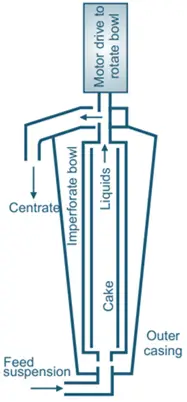Principles of Super Centrifuge
- The super centrifuge, also known as an ultracentrifuge, operates on the principle of generating extremely high centrifugal forces to separate particles based on very small differences in density.
- These centrifuges can achieve speeds much higher than conventional centrifuges, enabling the separation of sub-micron particles and molecules.
Construction of Super Centrifuge
- Rotor/Bowl: A high-strength rotor that can withstand extremely high speeds.
- Drive System: A powerful motor and spindle designed for ultra-high-speed rotation.
- Vacuum System: Often includes a vacuum chamber to reduce air resistance and heating due to friction.
- Cooling System: Maintains temperature control to prevent overheating during high-speed operation.
- Control System: Advanced control panel for precise adjustment of speed, temperature, and other parameters.
- Safety Enclosure: A robust housing to contain the rotor and ensure safety during operation.
Advertisements

Working
- Loading: The sample is loaded into the rotor or sample tubes, which are then placed in the centrifuge.
- Acceleration: The centrifuge accelerates to ultra-high speeds, generating enormous centrifugal forces.
- Separation: Particles are separated based on density differences, with denser particles moving to the outer edge of the rotor and lighter particles staying closer to the center.
- Deceleration: The centrifuge decelerates after the desired separation is achieved, and the separated components are collected.
Advertisements
Uses
- Biotechnology and molecular biology for the separation of viruses, proteins, nucleic acids, and other macromolecules.
- Pharmaceutical industry for purifying drugs and vaccines.
- Nanotechnology for separating nanoparticles.
- Analytical laboratories for sedimentation analysis and density gradient separation.
Merits
- Capable of separating extremely small particles and molecules.
- Provides high-resolution separation based on small density differences.
- Essential for advanced research and analytical applications.
- High precision and reproducibility.
Advertisements
Demerits
- Very high initial cost and operational expenses.
- Requires specialized training for operation and maintenance.
- Limited to specific applications where ultra-high-speed separation is necessary.
- Potential for rotor damage or sample disruption at very high speeds.

